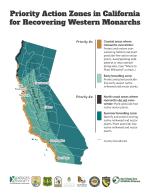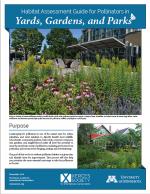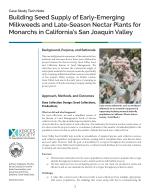As a science-based organization, the Xerces Society produces dozens of publications annually, all of which employ the best available research to guide effective conservation efforts. Our publications range from guidelines for land managers, to brochures offering overviews of key concepts related to invertebrate conservation, from books about supporting pollinators in farmland, to region-specific plant lists. We hope that whatever you are seeking—whether it's guidance on making a home or community garden pollinator-friendly, advice on developing a local pesticide reduction strategy, or detailed information on restoring habitat—you will find it here!
Find Publications
Use the search functions to sort by publication type (books, guidelines, fact sheets, etc.), location, and/or subject (agriculture, gardens, pollinators, pesticides, etc.).
The western monarch population is at a critically low level. Work to improve monarch habitat in California is more important than ever. This fact sheet identifies the most important actions that should be taken in five different regions of California, and provides notes and guidance on selecting the appropriate species of milkweeds and nectar plants.
The goal of this tool is to evaluate pollinator habitat at a given urban, suburban, or rural site and identify areas for improvement. This process will also help users prioritize the most essential next steps to take for pollinators at the site.
Rethinking Weed Management at Home
Though insecticides pose the most obvious risk to bees and other pollinators, this factsheet focuses on herbicides because they too can be harmful. Learn about herbicides, their risk to pollinators, their use cases, and alternative solutions to manage weeds and unwanted plants.
Integrated Pest and Pollinator Management, or IPPM, is a strategic framework for managing pests while protecting pollinators. As its name implies, IPPM takes the core principles and practices of Integrated Pest Management (IPM) and adds specific considerations and strategies for protecting pollinators. The foundations of IPPM include conservation biological control, scouting and monitoring, identifying evidence-based treatment thresholds, and practicing non-chemical management strategies to reduce reliance on and use of pesticides.
Case Study Tech Note
This case study presents a summary of a three-year project to increase the commercial supply of native plant materials for western monarchs, specifically early-emerging milkweeds and late-season nectar plants of San Joaquin Valley ecotypes.
Essays on Invertebrate Conservation
Moths are all around us. They share our natural areas and gardens, and sometimes they share our food crops, and even our clothes. Love them or despise them, moths play profoundly important roles in our environment—as pollinators; as food for songbirds, bats, and other wildlife; as part of the clean-up crew that recycles organic waste; and more—and they deserve our conservation attention.
This fact sheet provides detailed information on hybrid sunflower crop pollinators, including a list of the most important native bees that visit this crop, and steps that can be taken to protect or enhance habitat for these pollinators. The information provided is based on field research conducted by Dr. Claire Kremen (University of California, Berkeley), Dr. Neal Williams and Nikki Nicola.
This fact sheet provides detailed information on watermelon crop pollinators, including a list of the most important native bees that visit this crop, and steps that can be taken to protect or enhance habitat for these pollinators. The information provided is based on field research conducted by Dr. Claire Kremen (University of California, Berkeley), Dr. Neal Williams and Nikki Nicola.
The threatened species categories used in Red Data Books and Red Lists have been in place for almost 30 years. The IUCN Red List Categories and Criteria provide an easily and widely understood system for classifying species at high risk of global extinction, so as to focus attention on conservation measures designed to protect them. This latest version of the classification system was adopted by the IUCN Council in February 2001 and reflects comments from the IUCN and SSC memberships and the final meeting of the Criteria Review Working Group.








